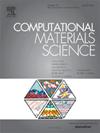光伏用三元和季硫系半导体的高通量筛选
IF 3.3
3区 材料科学
Q2 MATERIALS SCIENCE, MULTIDISCIPLINARY
引用次数: 0
摘要
组分工程提供了一种很有前途的方法来发现具有吸引人的光电特性的新半导体。基于高通量原子模拟的筛选提供了一种跨组合组合空间执行多目标优化的方法。在这项研究中,我们利用密度泛函理论(DFT)探索了三元ABX2和四元A2BCX4硫族半导体X∧{S, Se, Te}的化学空间,重点研究了它们的热力学稳定性、光电性质和缺陷行为。A2BCX4化学空间定义为A∧{Na, K, Rb, Cs, Cu, Ag}, B∧{Mg, Ca, Sr, Ba, Zn, Cd}, C∧{Sn, Ge}, ABX2化学空间定义为A∧{Na, K, Rb, Cs, Cu, Ag}和B∧{Al, Ga, In}。使用kesterite型排序和stannite型排序来模拟任一空间中的每种成分。研究人员利用GGA-PBEsol泛函和具有自旋轨道耦合(SOC)的杂化HSE06泛函对540个化合物进行了几何优化、电子结构和光学吸收计算,以确定形成和分解能、带隙和光谱限制最大效率(SLME)。基于HSE06+SOC计算,发现45个化合物具有稳定的抗分解性,并表现出SLME >;30%,表明作为单结太阳能电池吸收剂具有很高的潜力。虽然凯斯特矿的有序性通常比斯坦矿更稳定,但后者的带隙更窄,更适合太阳吸收。我们对两个候选化合物进行了详细的点缺陷计算,发现它们可能容易产生有害的反位点取代缺陷,这是三元和四元硫族化合物的常见问题。我们相信,通过在正离子或阴离子位点合金化,并掺杂合适的物质,进一步优化成分,将有助于使化合物更具耐缺陷性,我们的数据集为未来的研究提供了动力。本文章由计算机程序翻译,如有差异,请以英文原文为准。

High-throughput screening of ternary and quaternary chalcogenide semiconductors for photovoltaics
Composition engineering offers a promising approach to discover new semiconductors with attractive optoelectronic properties. Screening based on high-throughput atomistic simulations provides a way to perform multi-objective optimization across a combinatorial compositional space. In this study, we used density functional theory (DFT) to explore the chemical space of ternary ABX2 and quaternary A2BCX4 chalcogenide semiconductors with X {S, Se, Te}, focusing on their thermodynamic stability, optoelectronic properties, and defect behavior. The A2BCX4 chemical space was defined as A {Na, K, Rb, Cs, Cu, Ag}, B {Mg, Ca, Sr, Ba, Zn, Cd}, and C {Sn, Ge}, while the ABX2 chemical space was defined as A {Na, K, Rb, Cs, Cu, Ag} and B {Al, Ga, In}. Each composition in either space was simulated using the Kesterite-type ordering as well as the Stannite-type ordering. For a total of 540 compounds, we performed geometry optimization, electronic structure, and optical absorption calculations using the GGA-PBEsol functional followed by the hybrid HSE06 functional with spin–orbit coupling (SOC), to determine formation and decomposition energies, bandgap, and spectroscopic limited maximum efficiency (SLME). Based on the HSE06+SOC computations, 45 compounds were found to be stable against decomposition and showed SLME 30%, suggesting high potential as single-junction solar cell absorbers. Although the Kesterite ordering is generally more stable than Stannite, the latter shows narrower bandgaps which are more suitable for solar absorption. We performed detailed point defect calculations on two selected candidates and found that they may be prone to harmful anti-site substitutional defects, which is a common issue in ternary and quaternary chalcogenides. We believe that further composition optimization via alloying at the cation or anion sites, and doping with suitable species, will help make the compounds more defect-tolerant, and our dataset provides the impetus for future studies.
求助全文
通过发布文献求助,成功后即可免费获取论文全文。
去求助
来源期刊

Computational Materials Science
工程技术-材料科学:综合
CiteScore
6.50
自引率
6.10%
发文量
665
审稿时长
26 days
期刊介绍:
The goal of Computational Materials Science is to report on results that provide new or unique insights into, or significantly expand our understanding of, the properties of materials or phenomena associated with their design, synthesis, processing, characterization, and utilization. To be relevant to the journal, the results should be applied or applicable to specific material systems that are discussed within the submission.
 求助内容:
求助内容: 应助结果提醒方式:
应助结果提醒方式:


